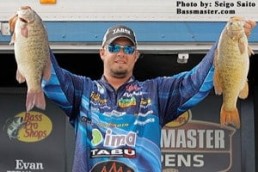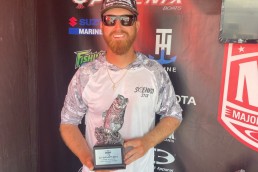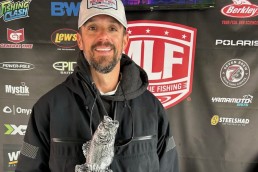A Conversation With Bassmaster Open Pro Michael Murphy
Were you expecting to do well when you saw this event on the schedule?
I have done well on Lake Erie in the past. Only fishing there twice before, I had a top 20 finish the first time, and the last time I fished Erie I caught 18-pounds the first day and then blanked the second day, mostly due to a huge weather change. Even in the events held out of Detroit I’d run out to the big water (Lake Erie) to catch them. Which is one reason I was excited for this event, it was held out of Sandusky. That meant the run to my favorite area would be much shorter. From Sandusky the run is only thirty to forty-five minutes, from Detroit, the run is typically about an hour, but with bad weather has taken me as long as three hours each way. I knew the extra time with my line wet would help me out quite a bit. I’d get at least an extra hour and a half or two hours of fishing each day.
So much of a tournament is won and lost during pre-fishing. Did you find them during pre-fish or during the tournament?
I went in with my mind open about what to expect. We are getting into the fall and this is the time of year where the fish really begin to move around. If you look at the Everstart finishes from the week before out of Buffalo. What I thought was interesting is guys were catching the fish deep, but there were some guys who caught them shallow. Which to me was like a light bulb going off. It meant the fish were started to move in. Plus given the year with the weather patterns, a lot of fish just stayed shallow this year. I am not sure if it was the rain or the nutrient run off or what, but a good portion of fish seemed to stay shallow all year.
When I drove up I drove up to Eastern Ohio and started there. I started near where Jonathon VanDam won the event two years ago. Overall, it was really a sub-par day to say the least. I caught a couple decent fish, a four-pounder and a three-pounder, but overall I didn’t catch a lot of fish. I did a lot of graphing and I pride myself in getting really good with the Humminbird side finder graph. I graphed everything from 10-foot to 40 and 50-foot and I didn’t see anything that looked good.
The next day I travelled a little further west in Ohio and tested the waters around there. Again, I didn’t find anything real stellar.
I should say that I went up early to pre-fish. I wanted to do real well and finish up the year strong so I gave myself plenty of time. Erie is a big lake to say the least so I gave myself plenty of time to figure it out.
On the third day, I finally found my way to Sandusky and launched there. I ran out to my favorite area, called Pelee Island. I didn’t catch much other than Walleye and Drum. To make matters worse there was a bad algae bloom. It was the blue green algae which is photosynthetic, cyanobacteria which can really make you sick. It was nasty, and everywhere.
So I was looking at the forecast for the next few days and it looked like there was going to be a lot of wind. I kind of backed up and punted, I spent the next two days just going largemouth fishing and looking. I was taking everything with a grain of salt. I was just sitting back and taking it in as we got a little closer to the tournament. I figured out how to catch about 13-pounds of largemouth, which isn’t too great, but it felt nice catching fish. In fact, I don’t think I’ve ever caught so many fish in one day. It really brought the fun factor back into it. On one day, I caught at least 70 bass, it was just nuts.
On the Tuesday before the tournament, I went back to Pelee Island and this time the wind had blown most of the algae out. My goal was to try and find a more accurate depth and I revisited a lot of the places that I fished in years past.
I was using the graph and again I wasn’t seeing a lot of fish. When I did see fish, it was just one or two paired up and that’s it. I had a real suspicion the fish were spread out and on the bottom.
I started fishing closer to the bottom. I switched to a crankbait and I started catching fish. Most of them were smaller, one to two pounds, but I was catching fish. Then I started catching a few fish on the drop shot. The one thing these two techniques had in common was I was catching them in the 12-15 foot range. I did check a couple deeper places, down to 30 to 35 feet.
The thing about Erie is once you find them at a particular depth you can rely on that is where they are going to be. I switched to a big tube, which I hadn’t fished there for four or five years, then I thought to myself maybe they want a snack and not a full meal. I switched to a smaller Reins Legend tube on a Sean Hoernke, Horn Toad Tackle 1/8- ounce. I caught a 4 pounder, then a couple three and a half pounders and I was thinking “OK, I am done.”
I moved about 200 yards away and caught another three and a half pounder. I started really looking at the tube hard, I could catch a few on the crankbait, but the tube was the bait catching the better fish. No joke, I was catching them with the Denali Rods Noirwood, 7-foot medium spinning rod. That rod is so balanced and so light that, I know it sounds cheesy, but I could tell the difference between a Drum, a Goby and a Smallmouth. A Drum would hit it with one hard thud. The Gobies would hit it, almost like bluegill, repeated little thumps, and a Smallmouth with two sharp thumps, similar to that of a Goby, but with not as many thumps. When I felt that Smallmouth bite I’d just open up my spool count to two and set the hook on a nice one.
A lot of guys fishing around me were nailing the Drum, catching one after another. I was catching four-pound Smallmouth. By the end of the tournament they were asking me how are you doing that. By knowing the difference in the bite I was able to not set the hook on a Drum. A Drum would smash the tube and I’d just let it sit there. Then I’d move it forward just a few feet and then I’d get the smallmouth bite. It’s like the Drum were sitting out deeper and I had to get my bait through them before I could get it to the Smallmouth. I’d almost always get a Drum bite before I’d get a Smallmouth bite. Had I not been able to tell the difference I would have caught a ton of Drum and never got the bait to the Smallmouth. I literally used the Denali Noirwood rod to decode the bites.
Give us a quick rundown of the tournament days. How did it all unfold?
On the first day of the tournament I wouldn’t say it was what I expected, but I caught 19-pounds, 10-ounces and I weighed in 3 black smallmouth and 2 green smallmouth. I’ll tell you what I mean by that here in a minute.
The second day I had a lot pressure around me. Some guys moved into the area knowing that several of the leaders were around there. On the second day, the water wasn’t near as rough making it a lot easier to get there as well. I am the type of guy where I don’t care how rough it is even if it takes me an extra two hours to get there, I am going to take my time and get there. A lot of guys won’t run in the big water like that. I’ve got my Ranger/Evinrude boat rigged to handle the big water. There is an All-Star service team on-site and I have great sponsors that will get it done and fix it for me if they need to. So I don’t worry about it, I just go.
I ended up day two with one black Smallmouth and four green Smallmouth.
On the final day, Nate Wellman was a few hundred yards away, Kurt Dove was a couple hundred yards away and one other guy was close by. These guys were great to fish around and we gave each other plenty of room. We had about 8-10 less boats around us that last day. I weighed in every fish I caught was a green Smallmouth.
What I mean by green Smallmouth is, once smallmouth get shallow they darken up. So when I started I was catching fish that had been there for a while. The green ones were fish that were moving into the spot. Most of the fish on day two and all of the fish on day three were fresh fish. Having a spot that replenished itself each day was the key.
The bite did slow down, but I was catching good quality fish. It was obvious that it was the perfect place and the tournament was won there. The event winner, Nate Wellman was within a few hundred yards and I finished third.
I picked that reef to practice in the first place because I knew that would be the first place the fish would move up to. It was a twelve-foot deep reef, way out in the middle of nowhere.
The fish were a little more active in the low light condition, and seemed to be up on the flats a little more. So each morning I would catch a few with the IMA Beast Hunter crankbait and on a dropshot with the Tabu Tackle Whipped Tail worm in watermelon or black. I guess they probably thought it was a leech, whatever it was they liked it. The crankbait was Fred’s perch color, which I think looked like a Goby to the fish.
It seemed like the bigger fish didn’t really get positioned on the hard edge until the sun was up for a few hours. About 10:30 or when I had my limit, which was about 16 pounds each day, I’d pick up the Reins tube and start catching the bigger fish.
On the final day, I caught 20-pounds relatively early and was culling up ounces all day. I was culling out a 4.2 with a 4.4 and I really had no idea what I had. When I finally weighed in and the scales read over 22-pounds I was tickled.
Tell us a little more about the spot.
Pelee Island is about 15-miles long and four or five miles wide. You can see it on satellite imaging. It’s a huge island. I was fishing shoals around the islands. They are just random areas of glaciation deposits that have been kept clean by the natural current coming around the tip of the island. The bottom floor of the lake is very clean, you can see on your side scan in some places where the glacier has pushed one bolder like 50-yards and cut a groove in the lake floor. There will be a groove two-foot wide by a foot deep and at the end of the groove will be a giant boulder.
I was finding small areas of rock, rock that was anywhere from a foot to two-feet wide and in small piles. I was drifting through my areas, and there were definitely key areas in that drift. It got to the point where I knew I was going to get bit in a certain area. I’d tell my co-angler, “OK get ready, here you go. The next ten-seconds you are going to get bit.” If you hadn’t been there in a little while, it was 100% you were going to get bit.
What equipment did you use for each of the techniques?
I used the Denali Noirwood 7-foot medium action spinning rod for the Reins tube. I used eight-pound fluorocarbon with that set up. For the Ima Crankbait I used a Denali Rosewood 7’6” cranking rod with 10-pound test fluorocarbon. I also fished the dropshot on a Denali Noirwood 7-foot medium action spinning rod and eight-pound fluorocarbon and a Reins Tungsten weight.
I can’t tell you enough how important that rod was with the tube. That rod is sweet and being able to tell the bites like I was, made all the difference in the world. My average fish was over four-pounds. Those are some tank Smallmouths and having the right rod with that light line was extremely important.
So what’s next for you?
I am heading for the final BASS Northern on Lake Oneida later in the fall. I set out to fish the BASS opens because it opens the doors to a lot of new media outlets my sponsors and myself. FLW has some unique media opportunities, as does BASS, so I wanted to be diverse this year to increase my promotional reach. Now I find myself sitting in eighth place for Angler of the Year and the top five qualify for the Bassmaster Elite Series. I am not sure what I will do if I make it, but it’ll be nice to have options. I’ll discuss it with my sponsors and my family and make a decision. When it comes down to it, I have to go the direction that makes best economic sense.
I appreciate everything FLW has done for me up until this point. However, I am not going to lie, this year has been a struggle. When you are part of the cut backs and it has nothing to do with your promotion or fishing ability, it puts it on you to do what you have to do to stay out there. If you don’t make wise decisions the dream might be over. You might not be able to make it much longer.
There is no telling what is going to happen. I need to start by going to Oneida and taking care of that business. After that, I’ll get together with my team of sponsors, and my family and figure out what is the best business decision for all of us. If I were to make it to the Elite Series and make the switch, it would be a business decision.
(This Article Was Provided By True Image Promotions)
























